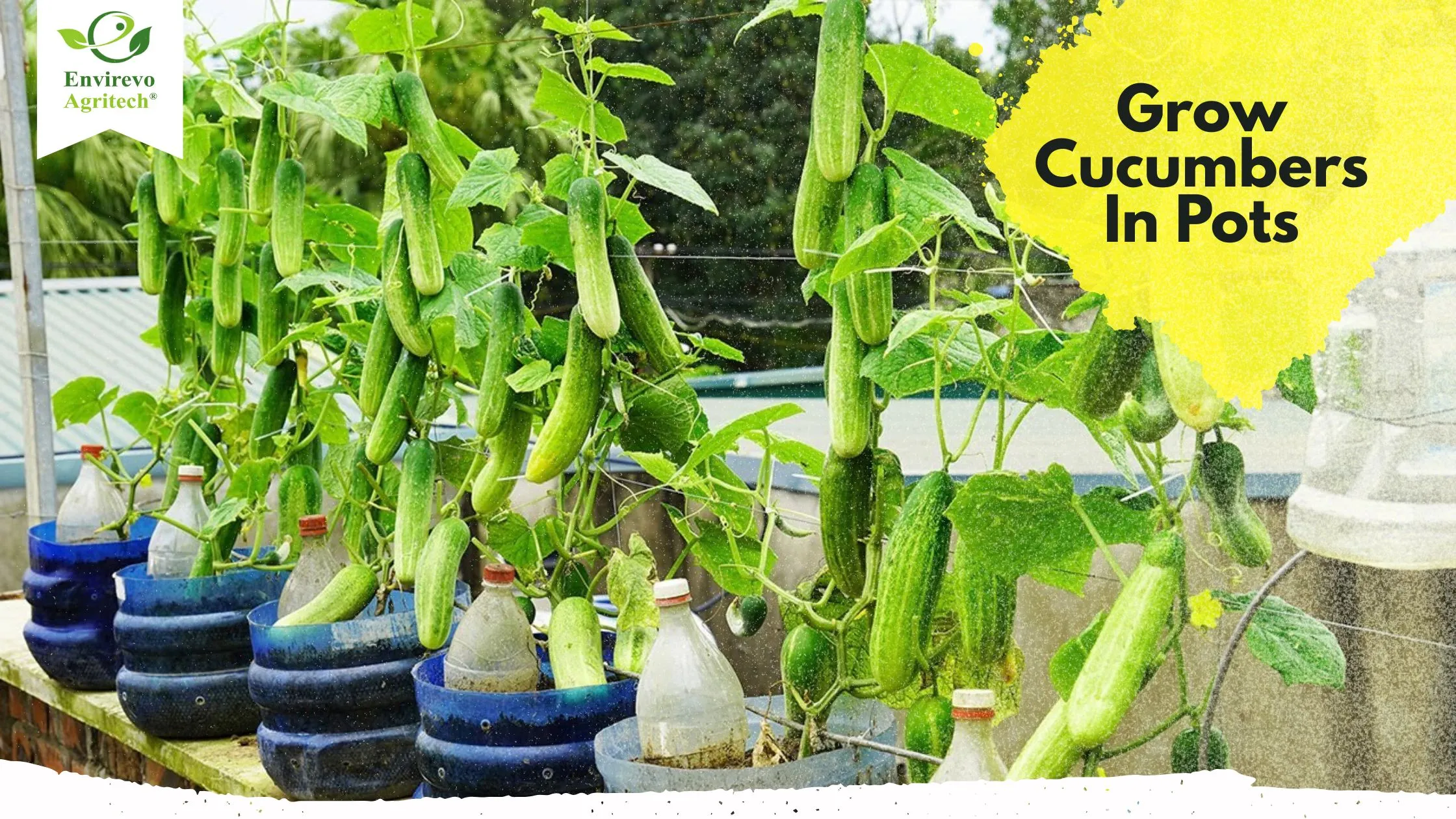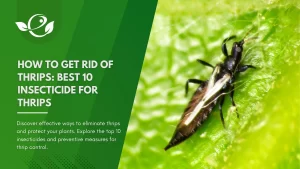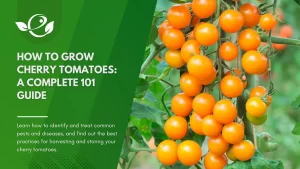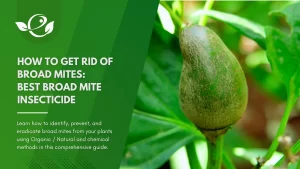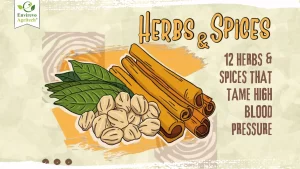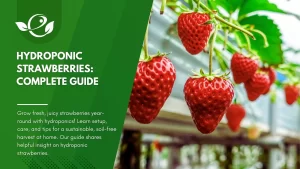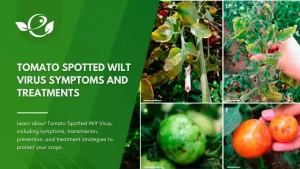Table of Contents
Crisp, refreshing, and delightfully easy to grow—cucumbers are a gardener’s favorite, even for those without traditional garden beds. If you’re short on space or living in an apartment, growing cucumbers in containers offers a fantastic way to enjoy a bountiful harvest on patios, balconies, or even sunny windowsills. With the right guidance, anyone can cultivate thriving cucumber vines in pots. This comprehensive guide will take you through everything you need to know—from selecting the right container to harvesting your first crisp cucumber.
Why Growing Cucumbers in Containers Is Worth It
Container gardening isn’t just for herbs or flowers—vegetables like cucumbers thrive in the right setup. Growing cucumbers in containers gives you more control over soil quality, watering schedules, and sunlight exposure, reducing the risk of soil-borne diseases and pests.
Moreover, cucumbers grow rapidly and produce generously under the right conditions. With just a few pots, you can enjoy a summer full of fresh cucumbers perfect for salads, pickles, and smoothies. Whether you live in a high-rise apartment or have limited garden space, container gardening ensures you’re never too far from a homegrown harvest.
Choosing the Best Cucumber Varieties for Container Growing
Not all cucumbers are created equal, especially when you’re working with containers. Selecting the right variety is the first crucial step toward success.
Bush vs. Vining Cucumbers
- Bush cucumbers are compact, making them ideal for small pots or tight spaces. They typically mature faster and are easier to manage in containers.
- Vining cucumbers, while more productive, require vertical support. They’re suitable for gardeners who have space for a trellis or vertical garden setup.
Top Container-Friendly Cucumber Varieties
- Spacemaster 80 – Compact, productive, and resistant to many common cucumber diseases.
- Bush Pickle – Great for small containers and ideal for making homemade pickles.
- Salad Bush – A dwarf variety that produces full-sized fruits in confined spaces.
- Patio Snacker – Specifically bred for container growing with a delicious, sweet crunch.
- Bush Champion – A high-yielding variety with excellent disease resistance.

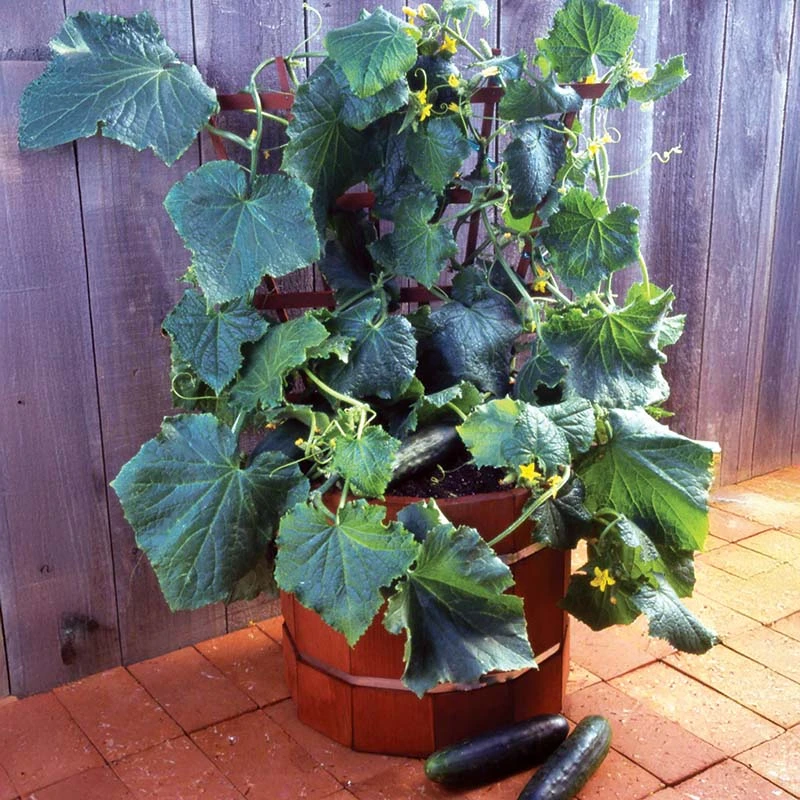
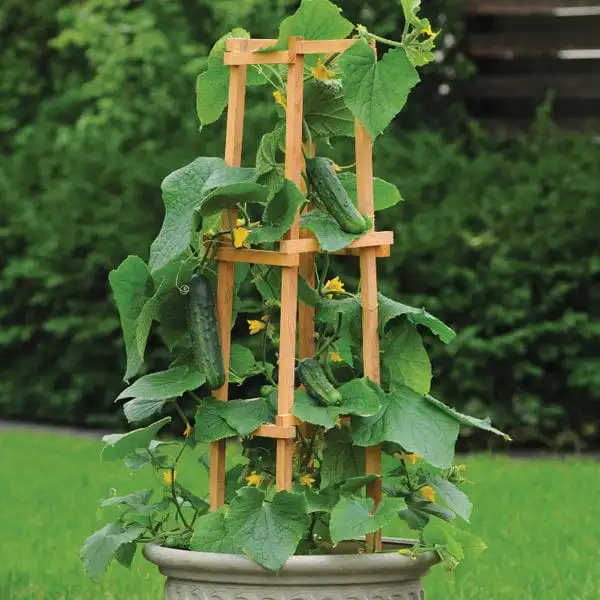
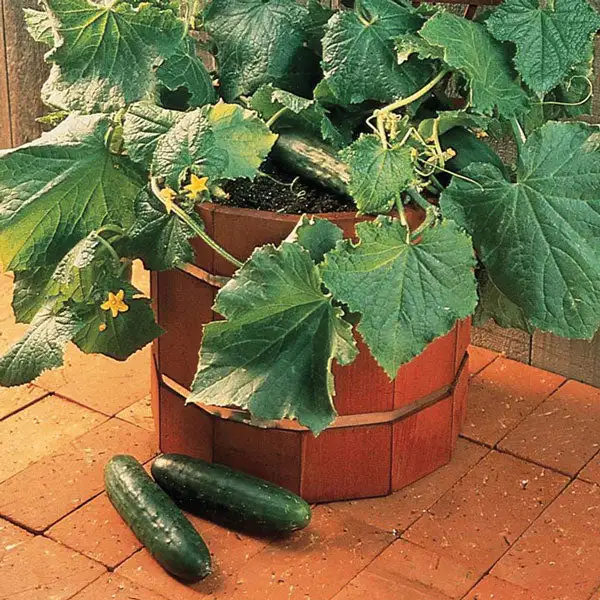
Choose varieties labeled “bush,” “patio,” or “container” for the best results in pots.
Selecting the Right Container for Growing Cucumbers
Container size plays a significant role in the success of your cucumber plants. Too small, and the roots won’t have enough room to grow; too deep, and water drainage may become inconsistent.
Ideal Container Specifications
- Size: A minimum of 12–14 inches deep and wide; a 5-gallon container is ideal for one plant.
- Material: Fabric grow bags, plastic pots, or food-safe buckets work well.
- Drainage: Ensure containers have multiple drainage holes. Cucumbers hate soggy roots, which can quickly lead to root rot.
For vining varieties, use rectangular planters or large pots with room for a support system. Bush types can even grow in large hanging baskets if space is extremely limited.
Preparing the Ideal Soil for Container Cucumbers
Unlike garden soil, potting soil for containers must provide proper drainage while retaining enough moisture to support fast-growing vegetables like cucumbers.
What Kind of Soil Do Cucumbers in Containers Need?
- Base: Use a high-quality, organic potting mix labeled for vegetables.
- Amendments: Add compost or aged manure to improve nutrient content.
- Drainage: Mix in perlite or coarse sand to improve aeration and avoid waterlogging.
A simple mix:
60% organic potting mix + 30% compost + 10% perlite or vermiculite
Avoid using topsoil or garden soil directly in containers—it compacts too easily and can harbor diseases.
How to Plant Cucumbers in Containers
Once you have the right container and soil, it’s time to plant. Cucumbers are sensitive to cold, so wait until the danger of frost has passed and soil temperatures are at least 65°F (18°C).
Seeds vs. Transplants
- Direct sowing is generally preferred because cucumber roots dislike being disturbed.
- Transplants are an option for gardeners in shorter growing seasons but must be handled gently.
Planting Instructions
- Fill the container with your soil mix, leaving about an inch from the rim.
- Sow seeds about 1 inch deep and 2–3 inches apart.
- Once seedlings emerge, thin them to 1–2 strong plants per container.
- Water gently and consistently.
If you’re using transplants, dig a hole deep enough to cover the root ball, firm the soil around it, and water thoroughly.
Watering and Fertilizing Container Cucumbers
Cucumbers are 95% water, so consistent watering is essential for healthy growth. However, too much water can drown the roots or encourage fungal issues.
Watering Guidelines
- Frequency: Water daily during hot weather; every 2–3 days in cooler conditions.
- Technique: Water at the base of the plant to avoid leaf diseases.
- Soil check: If the top inch of soil feels dry, it’s time to water.
Feeding Your Plants
Container soil loses nutrients quickly. Feed cucumbers regularly to support leaf growth and fruit production.
- Use a balanced fertilizer (10-10-10 or 5-10-10) every 2–3 weeks.
- Liquid seaweed or fish emulsion can be used as organic options.
- Apply diluted fertilizer directly to the soil, avoiding leaves to prevent burn.
Supporting Your Container Cucumbers
Even compact bush varieties can benefit from a little support, while vining types absolutely require it.
Why Trellising Matters
- Keeps fruit clean and off the ground
- Improves air circulation, reducing disease risk
- Makes harvesting easier
Best Support Options for Containers
- Vertical trellises attached to the container
- Tomato cages
- Wooden stakes and netting
- A-frame or ladder-style supports for more creative spaces
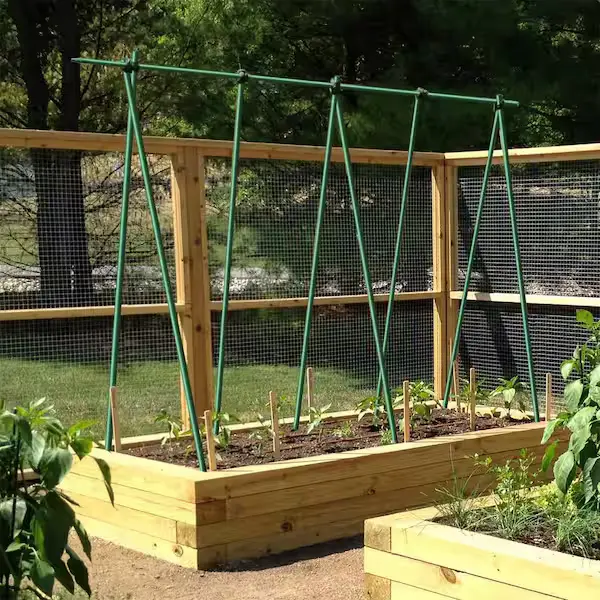
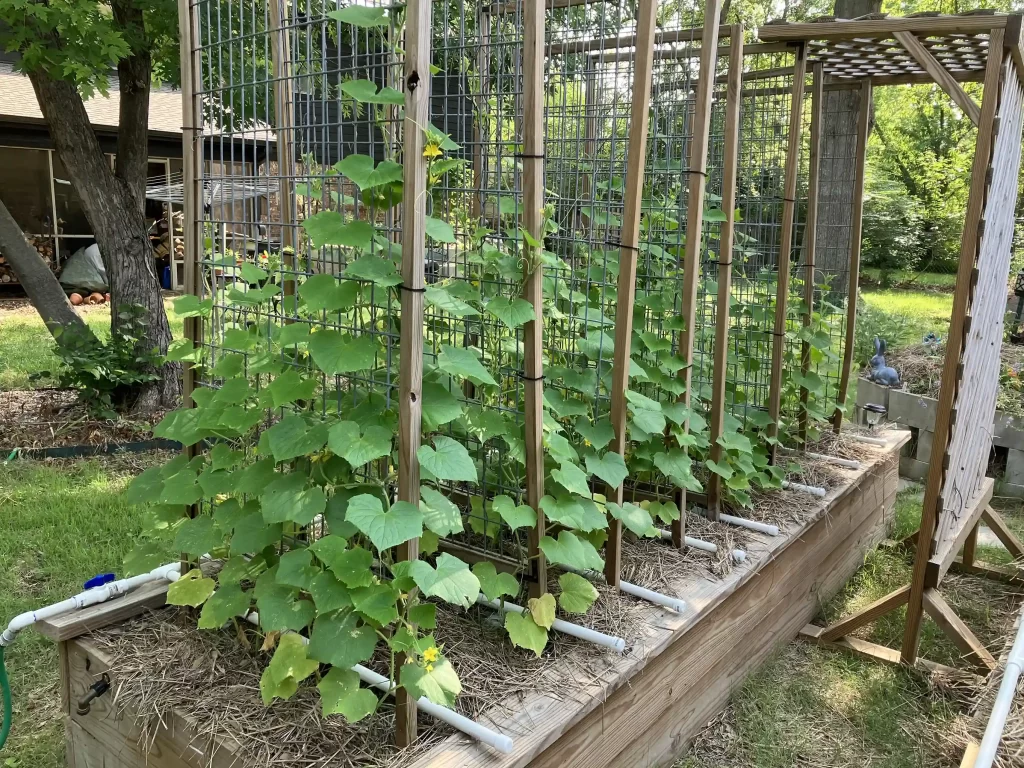
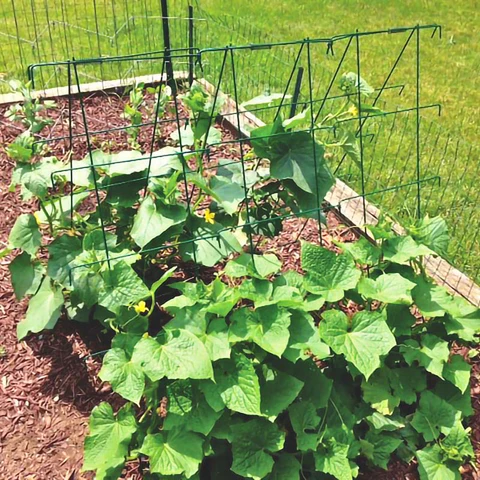
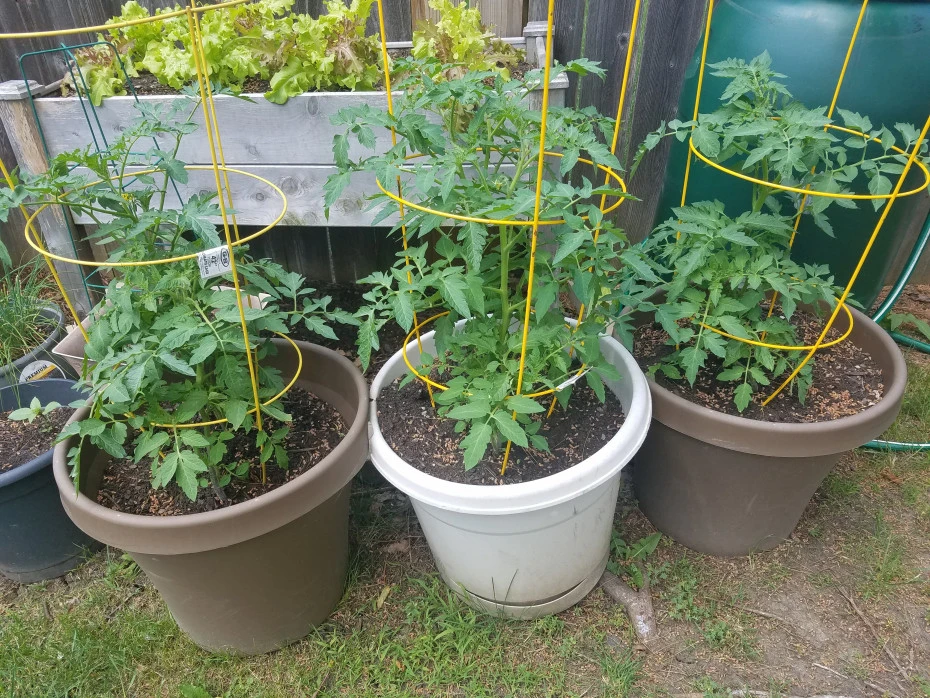
Secure your vines gently with soft ties or twine as they grow. Training your cucumber plants to climb not only improves yields but also maximizes container space.
Sunlight and Temperature Requirements
Cucumbers are warm-weather crops and thrive in full sun. Containers give you the flexibility to move your plants to chase the light throughout the day.
Light Requirements
- At least 6–8 hours of direct sunlight daily
- Place containers near south- or west-facing areas if possible
- Use grow lights if natural light is insufficient
Ideal Temperature
- Daytime: 70–85°F (21–29°C)
- Nighttime: No lower than 60°F (15°C)
Sudden drops in temperature can stunt growth or kill young seedlings. If a cold snap is expected, bring your pots indoors or cover them with frost cloths.
Common Problems and How to Avoid Them
While growing cucumbers in containers reduces certain risks, there are still challenges that can arise.
| Problem | Symptoms | Cause | Solution |
|---|---|---|---|
| Aphid Infestation | Sticky leaves, curled foliage, presence of tiny green/black insects | Sap-sucking insects feeding on plant juices | Spray neem oil or insecticidal soap regularly. Attract ladybugs. |
| Cucumber Beetles | Holes in leaves, yellowing, bacterial wilt symptoms | Insects that chew on foliage and spread diseases | Use floating row covers early in the season. Handpick or use yellow traps. |
| Spider Mites | Fine webbing, speckled or bronzed leaves | Tiny pests thriving in hot, dry conditions | Spray with water jet or horticultural oil. Maintain humidity. |
| Powdery Mildew | White, powdery spots on leaves | Fungal infection due to poor airflow and high humidity | Avoid overhead watering. Prune for airflow. Use organic fungicide if needed. |
| Downy Mildew | Yellow or brown angular spots on leaf undersides | Fungal infection favored by wet conditions | Remove affected leaves. Improve drainage. Use copper-based fungicide. |
| Bacterial Wilt | Sudden wilting of leaves and vines, despite moist soil | Spread by cucumber beetles | Remove infected plants. Control beetles. Rotate crops annually. |
| Poor Fruit Production | Few or misshapen cucumbers, flowers dropping | Lack of sunlight, poor pollination, irregular watering | Ensure full sun, consistent watering, and hand-pollinate if bees are absent. |
| Blossom-End Rot | Black sunken area on the fruit’s blossom end | Calcium deficiency or watering inconsistency | Keep soil consistently moist. Use calcium-rich fertilizer if needed. |
When and How to Harvest Cucumbers
Harvesting cucumbers at the right time is crucial to ensure crisp texture and optimal flavor.
Tips for a Perfect Harvest
- Check plants daily once fruit starts appearing.
- Harvest cucumbers when they’re firm, uniformly green, and before they get too large (overripe cucumbers turn bitter).
- Use garden shears or scissors to cut the fruit—don’t twist or yank.
Regular harvesting encourages the plant to produce more fruit. Leaving overripe cucumbers on the vine signals the plant to slow down.
Pro Tips for Successful Container Cucumber Gardening
- Rotate containers to follow the sun.
- Mulch with straw or shredded leaves to conserve moisture.
- Pinch off early blooms to encourage stronger root growth in young plants.
- Grow cucumbers with companion plants like dill, beans, or marigold to deter pests.
- Clean containers thoroughly between growing seasons to prevent disease buildup.
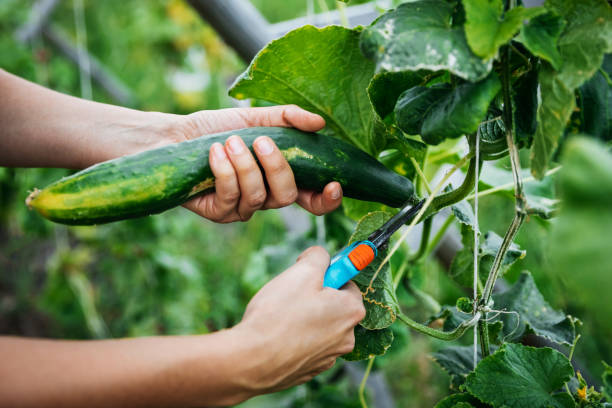
Final Thoughts
Growing cucumbers in containers is a rewarding and practical solution for anyone short on space but big on garden dreams. With the right variety, proper setup, and regular care, you’ll be enjoying homegrown cucumbers in just a few weeks. Container gardening gives you flexibility, control, and the joy of fresh produce right at your fingertips—no backyard required.
So grab a pot, some seeds, and get growing—your juicy, crispy cucumbers are just around the corner!
Frequently Asked Questions (FAQs)
How long does it take to grow cucumbers in containers?
Most cucumber varieties mature within 50–70 days after planting, depending on the type and growing conditions.
How many cucumbers can one container plant produce?
With proper care, a single container cucumber plant can yield 10–20 cucumbers throughout the season.
Can I reuse container soil for next season?
It’s best to refresh or replace the soil each season to avoid nutrient depletion and disease carryover.
Why are my cucumber plants having flowers but no fruit?
This usually happens due to poor pollination. Cucumber plants produce both male and female flowers, and without proper transfer of pollen—often done by bees—fruits won’t form. Hand-pollinate if pollinators are scarce.
